
In the North, temperature fluctuations can be quite significant throughout the year. These changes have a profound impact on the selection of materials for sweat rooms.
The North experiences cold winters with extremely low temperatures that can drop well below freezing, often accompanied by strong winds. In contrast, summers can bring relatively high temperatures, sometimes reaching into the hot and humid range. Such wide - ranging temperature variations pose unique challenges for any structure, especially a sweat room.
For sweat rooms in the North, excellent thermal insulation is crucial. During the cold winter months, a well - insulated sweat room can reduce heat loss, ensuring that the internal temperature can be maintained at a comfortable level for users while also reducing energy consumption. Materials such as high - quality fiberglass insulation or rigid foam insulation boards are often considered. These materials have low thermal conductivity, which means they can effectively prevent the transfer of cold air from the outside to the inside of the sweat room. In addition, proper insulation also helps during the hot summer months. It can keep the cool air inside the sweat room when the external temperature is high, preventing the room from overheating too quickly.
The materials used in sweat rooms need to be able to withstand the extreme cold and heat. In winter, some materials may become brittle in extremely low temperatures. For example, certain plastics may crack, so more durable materials like metal alloys with good low - temperature performance or high - quality wood treated to resist cold - related damage are preferred. In summer, materials should be able to resist expansion and warping due to high temperatures. Stone or ceramic tiles, for instance, are known for their stability in a wide range of temperatures and are often used on the floors or walls of sweat rooms in the North.
Temperature fluctuations in the North are often accompanied by changes in humidity. In winter, the cold air can hold less moisture, leading to drier conditions, while in summer, the air can be more humid. Sweat rooms, by their nature, also generate a significant amount of moisture. Therefore, the materials chosen must be moisture - resistant. Waterproof membranes or coatings can be applied to the walls and floors. Cedar wood, which has natural moisture - repelling properties, can also be a good choice for some parts of the sweat room structure.
With large temperature differences, materials will expand and contract. This can lead to gaps or structural damage if not properly accounted for. For example, when using wooden components, leaving small expansion gaps can prevent the wood from buckling as it expands in warmer temperatures. For metal components, using materials with similar coefficients of thermal expansion can ensure that joints and connections remain intact over time.

